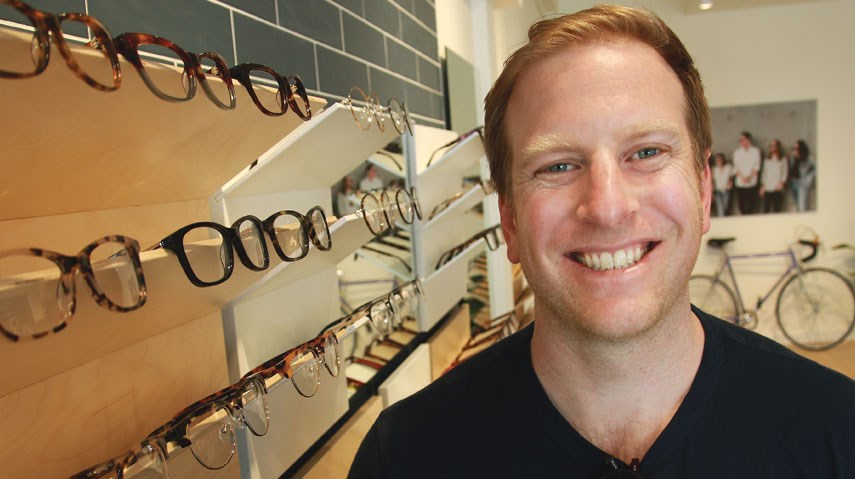If you want to see how bricks-and-mortar retail can withstand the onslaught of the Internet, look to the eyeglass business.
In the past few months, several new eyewear companies have opened street-front locations in Vancouver, including outlets by French lens manufacturing giant Essilor, the parent of Clearly, which also has two stores in the city despite making most of its money with online sales.
The Ollie Quinn brand has expanded to five Metro Vancouver stores since March while Bailey Nelson has confirmed its first two store openings this summer and “unconventional” retailer Warby Parker is said to be scouting locations, as is Montreal-based BonLook.
Ollie Quinn CEO Michael Andersen operated three eyewear stores in Metro Vancouver under a partnership with Bailey Nelson until March. He then rebranded the stores as Ollie Quinn, and the company opened a fourth store on Main Street. It then opened a fifth Ollie Quinn on West 4th Avenue on May 2.
Warby Parker, in particular, shows how retailers are harnessing online data to improve brick-and-mortar performance, according to U.S. retail analyst Soumya Das of Inpixon.
Warby Parker uses a “showrooming format” at its storefronts, Das explained. Such bricks-and-mortar innovations leverage technology and online data to “improve the customer experience and tailor towards consumer preferences and needs,” he said.
“It’s crucial for retailers to influence the buying decision right then and there in the showroom, so they’re buying from the retailer, rather than buying online elsewhere,” Das said. “I expect more retailers to implement this structure and experiment with new store concepts in order to combat online giants like Amazon and e-commerce companies.”
And with these experimental efforts, he says, “traditional retailers will have an opportunity to compete if they’re willing to evolve. We will continue to see more conventional stores closing: however, we will simultaneously see unconventional stores opening.”
“It would be a no-brainer that Warby Parker would at least consider opening a store in Vancouver,” said Craig Patterson, a retail analyst and owner of Retail Insider Media.
“I’d be surprised if there weren’t already negotiations underway for at least one Vancouver store. My guess, given where Warby Parker has opened stores in Canada as well as internationally, is that we’ll see Warby Parker open either in Gastown or on Robson Street.”
But the outlook for street retailers goes beyond eyewear.
So far, bricks-and-mortar retailers across Western Canada appear to be not only holding their own against online competition, but also acting as the anchor for large mixed-use retail developments, according to a national retail report from Colliers International.
The first-quarter study found that British Columbia retail sales increased by 7.4 per cent in 2016 from a year earlier; Manitoba saw a 4.2 per cent sales surge, while Saskatchewan retailers enjoyed a 2.2 per cent increase to $18.77 billion.
Alberta, which was hammered by lower oil prices, was the only western province to see a dip in consumer sales, down a modest 1.2 per cent to $74.2 billion, second only to British Columbia, but Alberta has recovered early in 2017.
As a comparison, online retail sales in Canada in 2016 totalled $20.6 billion, representing 5.7 per cent of consumer spending.
But bricks-and-mortar stores offer a physical advantage that digital retailers lack.
Regional shopping malls, said James Smerdon, Colliers vice-president and director of retail consulting, are especially well placed to leverage the true strength of bricks and mortar.
“Regional shopping centres near major markets are particularly well positioned for future redevelopment, occupying large sites of 50 to 100 acres in urban or suburban areas, on major arterial roadways or intersections, and centrally located within municipalities,” Smerdon noted.
In Metro Vancouver, Shape Properties is currently developing the aging Brentwood Town Centre mall with a cluster of high-rise residential towers, skirted by a revamped shopping centre. Oakridge Centre is having a similar facelift, as is the Lougheeed Town Centre mall.
Smerdon looks to Calgary’s Chinook Centre, which has survived for more than 60 years by continually evolving, to show how physical retail edges the virtual space. In 2010, Chinook expanded by adding 180,000 square feet of new retail space in a two-level wing accommodating 60 new retailers.
It is now planning yet another redevelopment that will add residential towers, a parkade and new outward-facing bricks-and-mortar stores, he noted.



